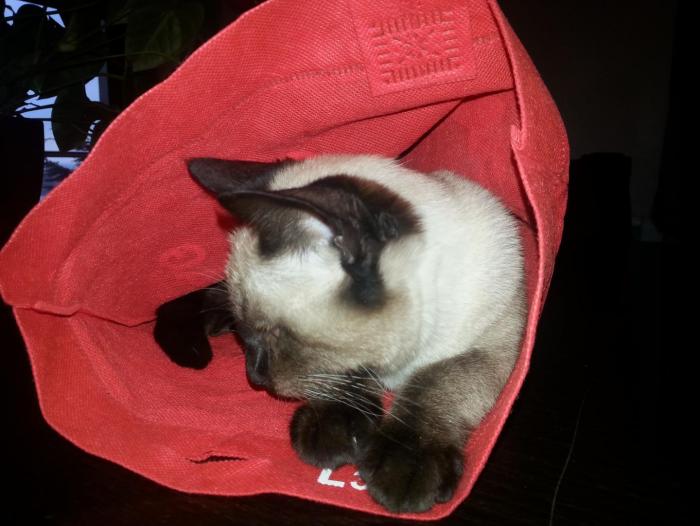Pet cats can suffer from stress triggered by a variety of events and situations, including conflicts with other cats and
changes to routine. While cats can adapt, sometimes the stress can be too much, with negative effects on their health.

When stressed, cats may stop exploring and hide away for long periods of time.
Image credit: Marta Amat, Autonomous University of Barcelona
Writing in the Journal of Feline Medicine and Surgery, a group of veterinarians from the Autonomous University of
Barcelona, Spain, explains that stress can impoverish the health of pet cats and increase their risk of disease.
The authors say that stress in pet cats can lead to behavior changes that are so difficult to manage that owners end up
relinquishing them or having them euthanized.
In their paper, they discuss the causes and effects of stress in pet cats and strategies on how to prevent and reduce
it.
Some of the main causes of stress that they discuss include: changes to the pets’ environment, a barren environment, poor
relationships with humans, conflicts with other cats and lack of control and predictability.
The authors note that other new changes – such as the arrival of a new member in the household, or a change in the daily routine –
may also be stressful for the family’s feline pet.
Effects of stress in cats
In cats, stress distorts normal behavior – leading to reduction or excess of it. Generally, stress causes a domestic cat to become
less active and playful and engage in markedly fewer positive interactions with other cats and humans.
The authors note that stress can also cause pet cats to eat less – or more, in some circumstances – than usual.
Stress can also trigger compulsive behavior in domestic cats, such as over-grooming, to the point where the animal
loses its fur, showing patches of bare skin. But sometimes, stress can have the opposite effect, causing the cat to be neglectful
about grooming.
Another sign of stress in a pet cat is increased urine spraying and increased vigilance – the animal can also become a lot more
vocal than usual.
Cats are naturally curious and social animals, but when stressed, they may stop exploring and hide away for long periods of time.
They can also become more aggressive.
Often, owners do not realize that stress is the reason their pet is behaving like this, say the authors, especially if there are
no other, more obvious, signs.
Reducing conflict
In their review, the authors cover a range of strategies that owners can use to help reduce stress in their pet cat.
For example, they describe a three-phase method for reducing conflict between cats under the same roof.
It is important that to begin with, the cats are kept in separate parts of the house – each with its own space, litter
tray, food and water bowls, scratching posts, toys, and so on.
Then, the cats are introduced to each other’s territory (without the other cat being present) – primarily so they can get used to
each other’s smell. In this phase, the owner may also take a clean cloth, rub it on the scent gland of one cat, and then rub the
scented cloth on the cheek of the other cat. The authors call this phase “olfactory habituation.”
When the cats appear to be relaxed in each other’s territory (still in the absence of the other), the next phase, called “visual
habituation,” can begin. In this phase, the cats get to see each other through a safe barrier – for example a mesh door – while they
are engaging in pleasant activity.
The duration of these “visual contact” sessions is gradually increased, until the final phase, “direct contact habituation,” when
the mesh or barrier is removed and the animals are allowed to naturally approach each other physically.
Environmental enrichment
Another stress reduction approach that the authors describe is environmental enrichment, where the physical, social and complexity dimensions of
the cat’s life are enriched.
In this approach, the cat is given its own space with its own resources (food and water bowls, toys, etc), where it can feel
comfortable and relaxed, without feeling threatened by other cats and dogs or other pets.
As cats spend a lot of time foraging, their space should be enriched with “puzzle feeders” and by hiding food in different
places.
For cats that spend a lot of time indoors, their toys should be changed frequently to pique their interest and curiosity. Toys
that mimic small, moving, catchable prey are particularly effective for this.
Another way to enrich the pet cat’s environment is to install shelves, cat trees or platforms so the pet can explore its
space vertically as well as horizontally. Cats like using height as a vantage point, and they like to hide in places above the
ground.
The authors also mention studies that suggest giving cats places to hide can reduce stress.
Finally, cats, like humans, have different temperaments, and this needs to be considered when deciding strategies for breeding and raising cats, note the authors.
The full text of the study – which details all the strategies and discussion behind them – is available free to view for a short
time at this
link.
Earlier this year, Medical News Today learned of a study by veterinary clinicians from the University of Lisbon, also published in the
Journal of Feline Medicine and Surgery, that showed how classical music can help cats relax
during surgery.
Veterinarian Dr. Miguel Carreira, the senior study investigator, said he plays classical music when seeing cats in his clinic and
noticed that it made cats calmer, more confident and tolerant, particularly during George Handel compositions.
Written by Catharine Paddock PhD